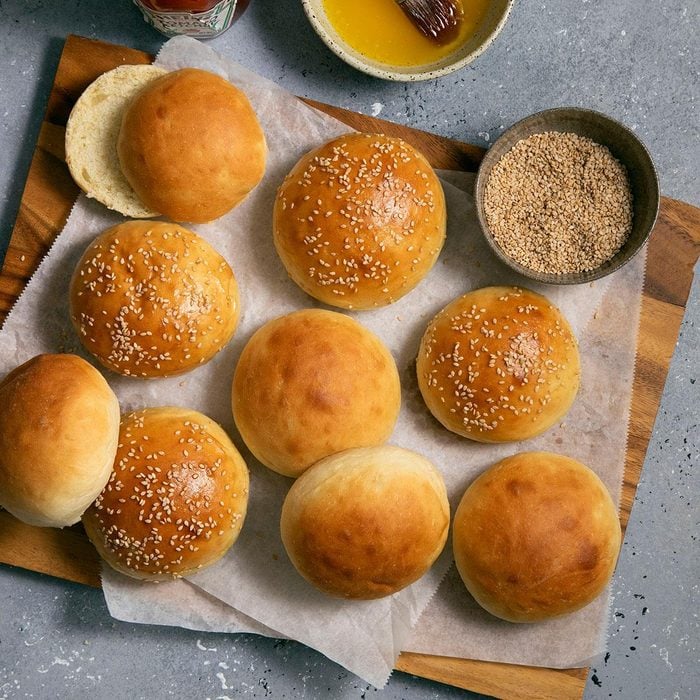Homemade hamburger buns sound like something only a professional chef would make. And, yes, I am one of those professional chefs who used to make burger buns at my restaurant. But I’ve taught many of my friends how to make hamburger buns at home, and I can confidently say that homemade bread doesn’t require any special training—just the desire to eat the freshest bread around. Still doubtful? Check out our ultimate guide to baking bread.
Armed with the right hamburger bun recipe, you can prep and cook soft, squishy buns in less than an hour. Our 40-minute burger buns use more yeast than normal, which is a little trick I used at my restaurant when we were running short on dough. The extra yeast gives the bread a boost and significantly reduces the prep time. So instead of preparing the dough hours ahead of time, you can simply knead it and then shape it into buns. They will rise on the baking sheet while the oven preheats.
Ingredients for Hamburger Buns
- All-purpose flour: We make our burger buns with all-purpose flour, but you can use bread flour if you prefer.
- Active dry yeast: Unlike instant-rise or quick-rise yeast, active dry yeast has to be proofed—or activated—in warm water. Proofing yeast is an important baking step because it ensures the yeast is still alive. In this recipe, you’ll let the yeast, oil and sugar mixture stand for a minimum of five minutes. This allows the yeast to feed from the sugar and become foamy. If this chemical reaction doesn’t happen, the yeast is no longer good.
- Warm water: Use a thermometer to ensure your water is between 110° to 115°F. Water that’s too hot can kill the yeast.
- Canola oil: Oil aids in browning, helping the buns achieve a gorgeous appearance as they bake. We use a neutral oil like canola oil for this recipe, but you can use olive oil instead to give the buns a more robust flavor.
- Salt and sugar: Salt strengthens the dough’s gluten formation, and sugar provides the yeast with the nutrients it needs to grow.
- Egg: An egg enriches the dough in several ways. It adds flavor, helps with browning, and contributes to the bun’s perfect texture. The fat in the egg yolk makes the dough light and fluffy, and the protein in the egg white lends the crumb a pleasant chewy texture.
Directions
Step 1: Prepare the yeast
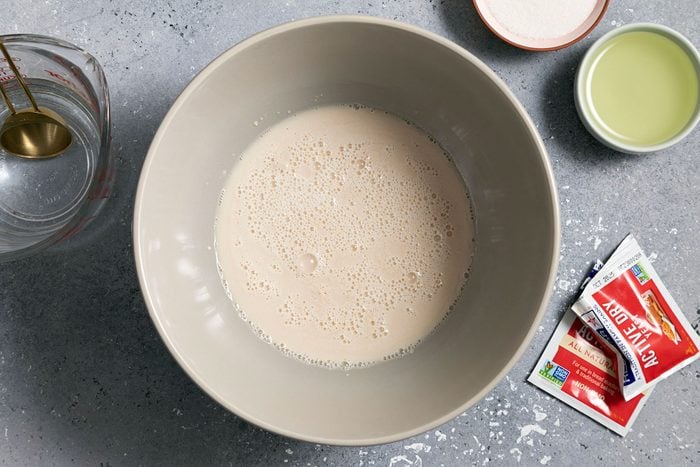
In a large bowl, dissolve the yeast in warm water. Add the oil and sugar, and let the mixture stand for five minutes.
Editor’s Tip: You can skip this step if you substitute quick-rise or instant-rise yeast. These tiny granules can be mixed directly into the flour. However, you’ll want to increase the water temperature to between 120° and 130°.
Step 2: Form the dough
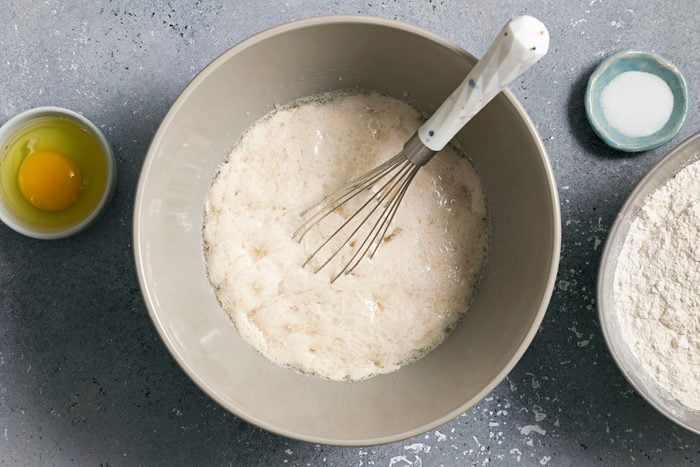
Add the egg, the salt and enough flour to form a soft dough.
Step 3: Knead the dough
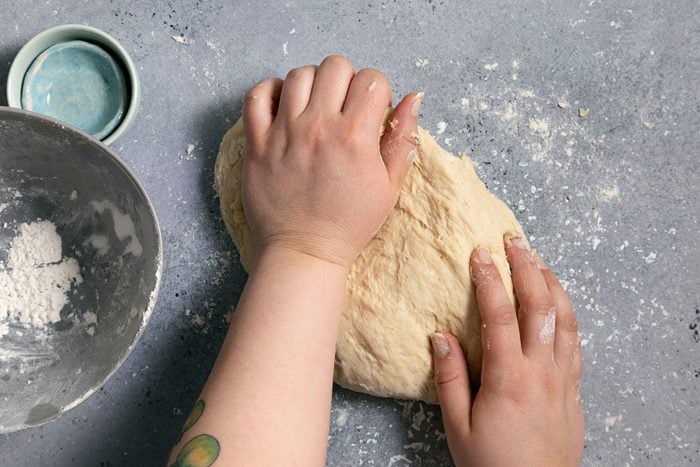
Turn the dough onto a floured surface. Knead the dough until it is smooth and elastic, three to five minutes. Do not let it rise.
Editor’s Tip: If the dough is sticky, add a little extra flour as you knead. By the end of the kneading process, the dough should be soft and should spring back to its original shape when poked gently.
Step 4: Divide the dough
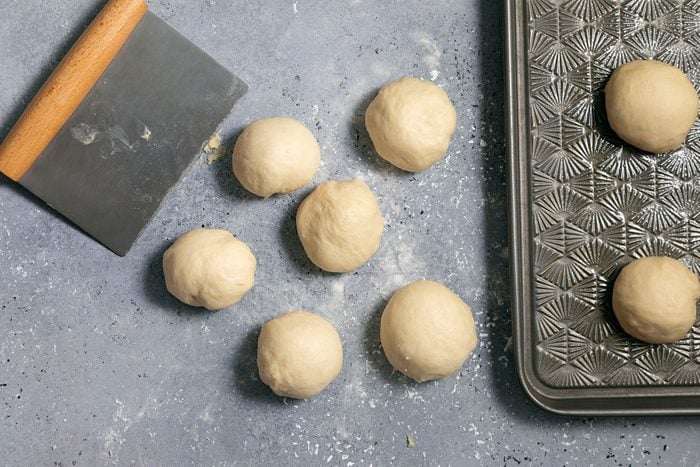
Divide the dough into 12 pieces. Shape each piece into a ball and place them 3 inches apart on greased baking sheets.
Editor’s Tip: A bench scraper is a useful kitchen tool for dividing dough. Plus, it’ll help you scrape off any hardened pieces of dough from the counter.
Step 5: Rest and bake the hamburger buns
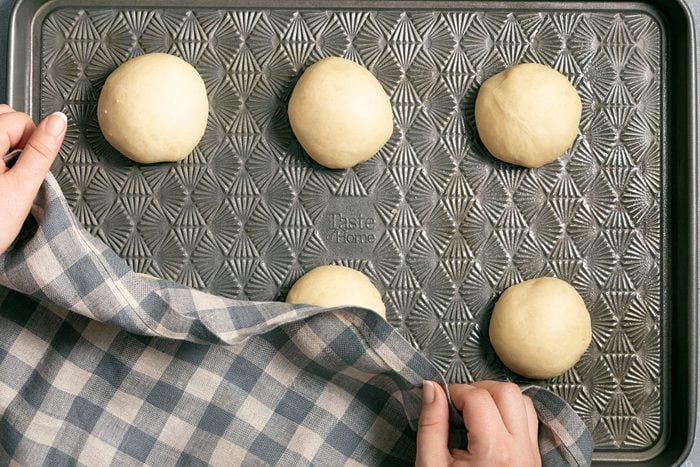
Preheat the oven to 425°.
Cover the dough balls on the baking sheet and let them rest for 10 minutes. Then, bake the buns until golden brown, 8 to 12 minutes.
Step 6: Let cool
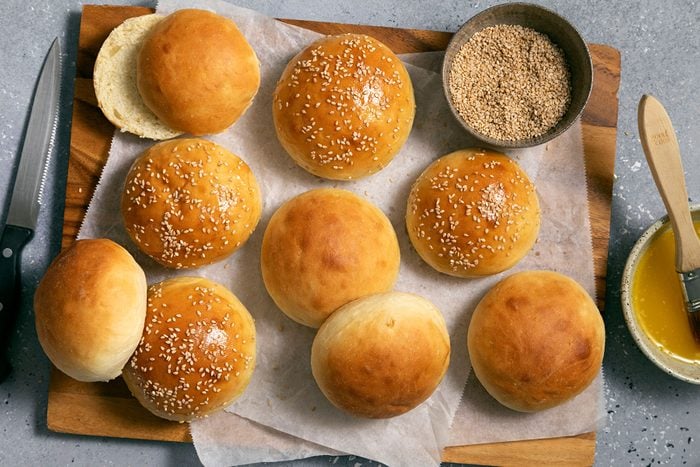
If desired, brush the buns with butter and sprinkle them with sesame seeds. Move the buns from the baking sheet to wire racks to cool.
Recipe Variations
- Change the bun size: To make larger burger buns for heartier sandwiches, divide the dough into eight portions instead of 12. Or turn the dough into slider buns or rolls by dividing it into 24 pieces. Adjust the cooking time as needed to make sure the buns are golden on the outside and cooked through on the inside.
- Vary the topping: After baking this hamburger bun recipe, brush the warm buns with butter and add your favorite toppings. Use white sesame seeds for a classic look, or try black sesame seeds, poppy seeds or everything bagel seasoning.
- Experiment with whole wheat: You can replace a portion of the all-purpose flour with whole wheat flour, but we don’t recommend using 100% whole wheat flour. This type of flour can make the buns dense, so you’ll want to experiment to get the proportion just right.
How to Store Hamburger Buns
These homemade burger buns taste best on the same day they’re baked, but you can store the leftovers in a bag on the counter for up to three days. You don’t want to store bread in the refrigerator, where the cold air will pull moisture from the buns and make them crumbly. Breathe fresh life into leftover buns by toasting them lightly before use.
Can you freeze hamburger buns?
You can freeze hamburger buns for up to six months. Wrap each bun in storage wrap and a layer of foil to protect it from freezer burn. Store the wrapped buns in a freezer-safe bag. When you’re ready to use them, thaw the buns on the counter overnight.
Hamburger Bun Tips
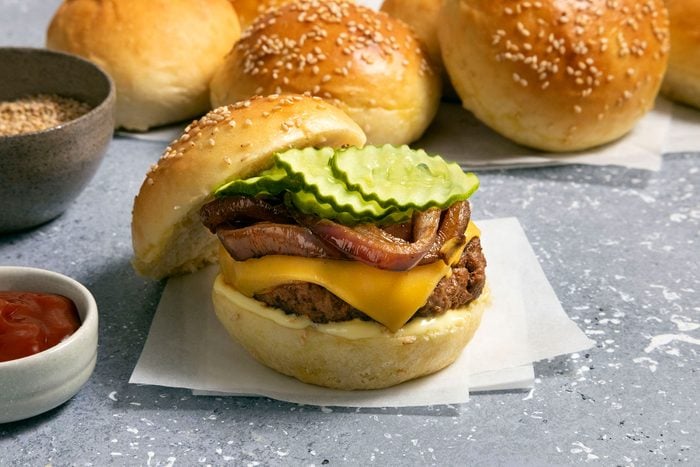
What can you do with hamburger buns?
- Burgers: Use these homemade burger buns to make your favorite burger recipe, whether that’s a classic all-beef patty or a vegetarian burger made with mushrooms or chickpeas. Don’t forget to pile on the burger toppings once you’re ready to dig in!
- Sliders: Form the dough into smaller pieces for slider recipes.
- Chicken sandwiches: Use these soft buns to make chicken sandwiches with grilled chicken breasts, leftover rotisserie chicken or fried chicken.
- Barbecue sandwiches: Soft buns are a fantastic choice for tangy pulled pork sandwiches, pulled brisket sandwiches or grilled eggplant sandwiches.
- Breakfast: Fry up an egg and layer it on a bun with ham, bacon or sausage for a stellar breakfast sandwich. Or use the buns to make a sweet breakfast, such as French toasted buns.
- Croutons: Transform the leftovers into croutons. They’ll taste amazing on your favorite salad or as a garnish for soup.
- Bread crumbs: This soft bread makes incredible homemade bread crumbs for breaded cutlets, meatballs, meatloaf and more.
What types of buns are best for hamburgers?
It’s best to avoid hard or crusty bread that won’t grip onto the burger patty, allowing it to slide out the back of the bun as you eat. This hamburger bun recipe creates a soft, squishy bun that’s perfect for burgers. The simple-tasting bread won’t overpower the fillings layered inside, either. If you want to try another homemade hamburger bun, try potato rolls or brioche rolls, or use a sourdough starter to give the rolls that sourdough character.
How do you store leftover yeast?
This recipe doesn’t use an even number of yeast packets, so you’ll want to store any unused yeast in an airtight container in the refrigerator for up to four months. If you’re unsure about the type of yeast to use, see our all-about-yeast guide, which includes information on active vs. rapid-rise vs. fresh yeast.



















